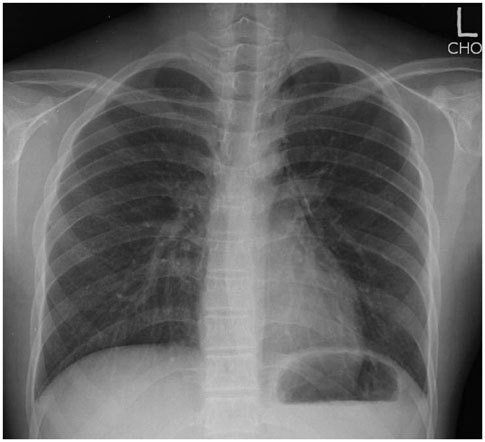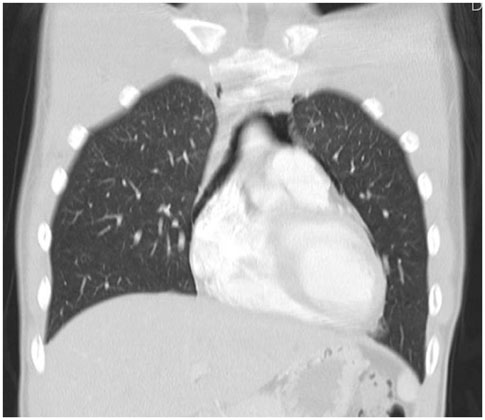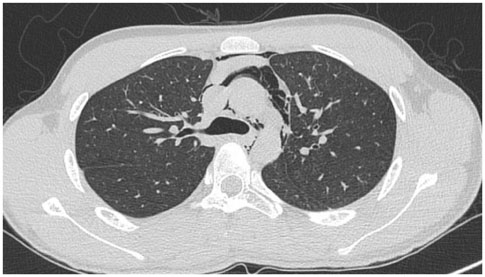Yonsei Med J.
2015 Sep;56(5):1437-1442. 10.3349/ymj.2015.56.5.1437.
Spontaneous Pneumomediastinum: A Rare Disease Associated with Chest Pain in Adolescents
- Affiliations
-
- 1Department of Pediatrics, Samsung Changwon Hospital, Sungkyunkwan University School of Medicine, Changwon, Korea.
- 2Department of Pediatrics, Heart Vascular Stroke Institute, Samsung Medical Center, Sungkyunkwan University School of Medicine, Seoul, Korea. herzhuh@skku.edu
- KMID: 2163641
- DOI: http://doi.org/10.3349/ymj.2015.56.5.1437
Abstract
- PURPOSE
Spontaneous pneumomediastinum (SPM) is a rare entity, with only a few cases reported, especially in adolescents. We aimed to analyze the clinical characteristics of SPM in adolescents and the diagnostic implications of computed tomography (CT) and esophagography therein.
MATERIALS AND METHODS
This retrospective descriptive study was conducted as a review of medical records of 416 adolescents (10-18 years of age) with chest pain from March 2005 to June 2013. Information on clinical presentation, methods of diagnosis, hospital stay, and outcomes were collected and analyzed.
RESULTS
Among adolescents complaining of chest pain, 11 patients had SPM (11/416, 2.64%). All patients presented with pleuritic chest pain, and 54.5% reported neck pain as the most common associated complaint. Clinical findings were nonspecific, and initial chest X-ray assessment was diagnostic only in three of 11 patients. However, reassessment of chest X-ray revealed diagnostic findings of SPM in five of the remaining eight patients. CT was diagnostic in all patients, while esophagography and echocardiogram were uninformative. Symptomatic improvement was noted within 2.45+/-1.2 hours (range, 0.5 to 4) after supportive care; mean hospital stay was 4.54+/-0.99 days (range, 2 to 6). No recurrence was observed.
CONCLUSION
SPM is a rare disease that should be considered in adolescent patients with pleuritic chest pain. Careful reading of initial chest X-rays is important to avoiding further unnecessary investigations. SPM is self-limited and treatment is supportive; nevertheless, if there are no indications of esophageal rupture, urgent esophagography is not recommended.
MeSH Terms
-
Adolescent
Analgesics/*therapeutic use
Chest Pain/diagnosis/*etiology
Child
Female
Follow-Up Studies
Humans
Length of Stay
Male
Mediastinal Emphysema/complications/*diagnosis/*therapy
Medical Records
*Oxygen Inhalation Therapy
Rare Diseases
Retrospective Studies
Risk Factors
Tomography, X-Ray Computed
Treatment Outcome
Analgesics
Figure
Reference
-
1. Abolnik I, Lossos IS, Breuer R. Spontaneous pneumomediastinum. A report of 25 cases. Chest. 1991; 100:93–95.2. Newcomb AE, Clarke CP. Spontaneous pneumomediastinum: a benign curiosity or a significant problem? Chest. 2005; 128:3298–3302.3. Mondello B, Pavia R, Ruggeri P, Barone M, Barresi P, Monaco M. Spontaneous pneumomediastinum: experience in 18 adult patients. Lung. 2007; 185:9–14.
Article4. Schulman A, Fataar S, Van der Spuy JW, Morton PC, Crosier JH. Air in unusual places: some causes and ramifications of pneumomediastinum. Clin Radiol. 1982; 33:301–306.5. Panacek EA, Singer AJ, Sherman BW, Prescott A, Rutherford WF. Spontaneous pneumomediastinum: clinical and natural history. Ann Emerg Med. 1992; 21:1222–1227.
Article6. Wintermark M, Schnyder P. The Macklin effect: a frequent etiology for pneumomediastinum in severe blunt chest trauma. Chest. 2001; 120:543–547.7. Bullaro FM, Bartoletti SC. Spontaneous pneumomediastinum in children: a literature review. Pediatr Emerg Care. 2007; 23:28–30.8. Koullias GJ, Korkolis DP, Wang XJ, Hammond GL. Current assessment and management of spontaneous pneumomediastinum: experience in 24 adult patients. Eur J Cardiothorac Surg. 2004; 25:852–855.
Article9. Haam SJ, Lee JG, Kim DJ, Chung KY, Park IK. Oesophagography and oesophagoscopy are not necessary in patients with spontaneous pneumomediastinum. Emerg Med J. 2010; 27:29–31.
Article10. Ozdemir H, Kendirli T, Dinçaslan HU, Ciftçi E, Ince E. Spontaneous pneumomediastinum in a child due to 2009 pandemic influenza A (H1N1) virus. Turk J Pediatr. 2010; 52:648–651.11. Takada K, Matsumoto S, Hiramatsu T, Kojima E, Watanabe H, Sizu M, et al. Management of spontaneous pneumomediastinum based on clinical experience of 25 cases. Respir Med. 2008; 102:1329–1334.
Article12. van Veelen I, Hogeman PH, van Elburg A, Nielsen-Abbring FW, Heggelman BG, Mahieu HF. Pneumomediastinum: a rare complication of anorexia nervosa in children and adolescents. A case study and review of the literature. Eur J Pediatr. 2008; 167:171–174.
Article13. Sahni S, Verma S, Grullon J, Esquire A, Patel P, Talwar A. Spontaneous pneumomediastinum: time for consensus. N Am J Med Sci. 2013; 5:460–464.
Article14. Banki F, Estrera AL, Harrison RG, Miller CC 3rd, Leake SS, Mitchell KG, et al. Pneumomediastinum: etiology and a guide to diagnosis and treatment. Am J Surg. 2013; 206:1001–1006.
Article15. Jougon JB, Ballester M, Delcambre F, Mac Bride T, Dromer CE, Velly JF. Assessment of spontaneous pneumomediastinum: experience with 12 patients. Ann Thorac Surg. 2003; 75:1711–1714.
Article16. Yellin A, Gapany-Gapanavicius M, Lieberman Y. Spontaneous pneumomediastinum: is it a rare cause of chest pain? Thorax. 1983; 38:383–385.
Article17. Kaneki T, Kubo K, Kawashima A, Koizumi T, Sekiguchi M, Sone S. Spontaneous pneumomediastinum in 33 patients: yield of chest computed tomography for the diagnosis of the mild type. Respiration. 2000; 67:408–411.
Article18. Mansella G, Bingisser R, Nickel CH. Pneumomediastinum in blunt chest trauma: a case report and review of the literature. Case Rep Emerg Med. 2014; 2014:685381.
Article19. Iyer VN, Joshi AY, Ryu JH. Spontaneous pneumomediastinum: analysis of 62 consecutive adult patients. Mayo Clin Proc. 2009; 84:417–421.
Article20. Rezende-Neto JB, Hoffmann J, Al Mahroos M, Tien H, Hsee LC, Spencer Netto F, et al. Occult pneumomediastinum in blunt chest trauma: clinical significance. Injury. 2010; 41:40–43.
Article21. Bejvan SM, Godwin JD. Pneumomediastinum: old signs and new signs. AJR Am J Roentgenol. 1996; 166:1041–1048.
Article22. Ba-Ssalamah A, Schima W, Umek W, Herold CJ. Spontaneous pneumomediastinum. Eur Radiol. 1999; 9:724–727.
Article23. Levin B. The continuous diaphragm sign. A newly-recognized sign of pneumomediastinum. Clin Radiol. 1973; 24:337–338.24. Moseley JE. Loculated pneumomediastinum in the newborn. A thymic "spinnaker sail" sign. Radiology. 1960; 75:788–790.25. Zylak CM, Standen JR, Barnes GR, Zylak CJ. Pneumomediastinum revisited. Radiographics. 2000; 20:1043–1057.26. Agarwal PP. The ring-around-the-artery sign. Radiology. 2006; 241:943–944.
Article27. Dissanaike S, Shalhub S, Jurkovich GJ. The evaluation of pneumomediastinum in blunt trauma patients. J Trauma. 2008; 65:1340–1345.28. Volpicelli G. Lung sonography. J Ultrasound Med. 2013; 32:165–171.
Article
- Full Text Links
- Actions
-
Cited
- CITED
-
- Close
- Share
- Similar articles
-
- Spontaneous Pneumomediastinum Complicating with Asthma
- A Recurrent Spontaneous Pneumomediastinum
- Idiopathic Spontaneous Pneumomediastinum: Radiologic and Clinical Features
- Spontaneous Subcutaneous Emphysema and Pneumomediastinum after Vesico-urethral Reimplantation under General Anesthesia
- A Case of Spontaneous Pneumomediatsinum during Taekwondo




